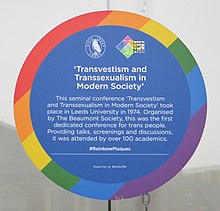Transvestism and Transsexualism in Modern Society
Organised in part by the Beaumont Society, a support group for transvestite women established in 1966, the conference provided information from social workers on legal and medical rights, and it gave a rare opportunity for attendees to meet other community members.
[2] Key figures in its delivery were June Willmott, a local Beaumont Society representative, and Caroline Robertson, a postgraduate researcher at the University of Leeds.
[5] Whilst the majority of attendees were invited by letter, there was some limited advertising of the event, including a notice in The Gryphon, the University of Leeds' student newspaper.
[7] Geoffrey Winter, a lead journalist at the Post, described his reaction as: I had reacted like a man toward women – standing up at their approach and pulling up chairs for them… and then realising and wondering why I was doing it.The main conference was held on 16 March at the University of Leeds, followed by a disco that evening, with a more informal day of workshops and open discussion on 17 March at Leeds Polytechnic.
[3] Mel Porter notes that despite its significance for transvestite and transsexual communities,[10] the conference did not attract wider support from the gay movement.

